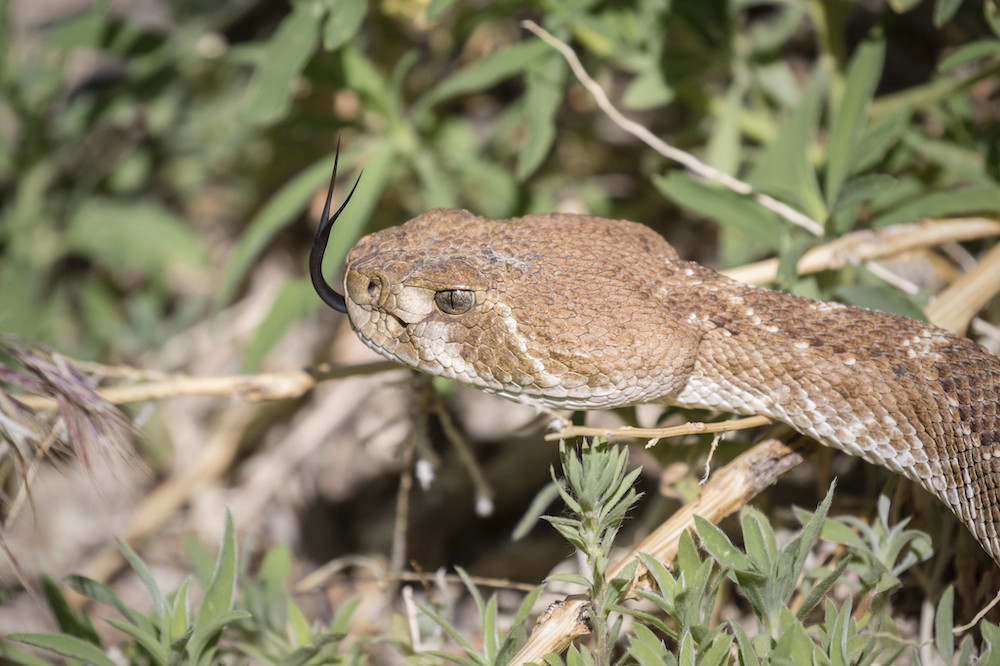
Welcome to Take It Outside! This week, we are getting to know our local reptiles and amphibians, collectively known as herptiles — or herps!
Today we are learning about rattlesnakes. These snakes often get a bad reputation because they are venomous, but they play a very important role in our food chains! Learn what to do if you encounter one, and how to keep yourself and the snake safe in today’s post.
If you haven’t already, please share your feedback on Take It Outside with us by filling out this evaluation form.
Blog Post:
Rattlesnakes are an important part of our ecosystem and both sightings and bites are rare. Learning about these snakes and what to do if you encounter one can help you to feel more prepared, confident, and comfortable when heading outdoors. Read today’s blog post from PEEC Marketing Manager Rachel Landman to learn what to do if you ever meet a rattlesnake.

Craft:
Bullsnakes are often mistaken for rattlesnakes. Become an expert at identifying the differences. Bullsnakes are not venomous and are great at controlling rodent populations — they are a friend to gardeners and homeowners that want to keep mice and rats away from their yard and home. Observe the above pictures carefully, noticing the differences between a bullsnake and a rattlesnake. Visit this website to explore more differences.
Use a paper-plate, construction paper, or cardboard to cut out each snake’s shape. Using colored pencils, markers, or crayons, color in the details of each snake’s pattern. Keep these for reference when you encounter a snake in your yard. Find instructions here.
Outdoor Challenge (Beginner):
Read today’s blog post and then go outside and practice what you would do if you saw a rattlesnake. Select a toy, ball, distinct rock, or another object that can be your snake and place it in your yard or along a nearby trail. Then, pretend you are out playing or hiking and practice how you’d respond!
This is a good way for kids to learn how to alert an adult of the snake’s presence. Role playing how you will stay calm, pause, and give the snake plenty of room while passing can help you get comfortable and feel prepared if you do ever encounter a real rattlesnake.
Outdoor Challenge (Advanced):
Rattlesnakes, like other reptiles, are ectothermic, or cold-blooded. Their body temperature is regulated by environmental sources. Ectotherms can survive with less food than endotherms, or warm-blooded animals, but they can only be active within a comfortable range of temperatures. Rattlesnakes tend to be active between ambient temperatures of about 60°F and 90°F, which explains why we don’t see them in the winter. They also require shelter, usually underground, if the temperature gets too hot.
Rattlesnakes are more common in low-elevation parts of the Pajarito Plateau, like along the Rio Grande. In higher-elevation areas, like Los Alamos townsite, rattlesnakes are usually found in warm, south-facing areas.
Go outside and look for places that provide warm areas for basking and sheltered places to cool off. You might see other ectotherms, like lizards and non-venomous snakes, taking advantage of these areas, too. Let us know what you saw!
Want to Learn More?
- Read about New Mexico’s “snake guy” and White Rock resident, Tom Wyant, who rescues and relocates snakes from people’s yards and homes in this profile from the Santa Fe New Mexican.
- Visit the American International Rattlesnake Museum’s website to discover more about these amazing creatures and their important role in the ecosystems they live in. This museum is located in Albuquerque, so you can visit them when they are able to re-open to the public. Be sure to tune in for our virtual Summer Family Evening with them later this summer! Details are coming soon.
- Local writer Kyle Dickman was bitten by a rattlesnake while visiting Yosemite National Park. He spoke about his experience last summer in a presentation at the Los Alamos Nature Center. You can read his account of this experience in his Outside Magazine article or listen to the podcast interview he gave to learn more about his bite and recovery. This is a fascinating story, but be warned that his account is quite graphic and may not be appropriate for all audiences.
- The New Mexico Wildlife Center has produced some educational videos about snakes. Hear a rattlesnake rattle, and meet a bullsnake and a hognose snake on their site.
- Snakes play an important part in the ecosystems of New Mexico. Learn about some ways snakes can be beneficial to humans here.
- If you find a snake in your yard and don’t want it there, don’t kill it or try to harm it. There are groups of volunteers who can safely relocate the snake for you. In Los Alamos and White Rock, you can call the non-emergency police dispatch line at (505) 662-8222 to be connected with volunteers. In other places in Northern New Mexico, you can call the New Mexico Wildlife Center at (505) 753-9505.
Share Your Experience:
Tell us what you learn about our local reptiles and amphibians this week! We’d love to see your photos, too. Please send them to takeitoutside@peecnature.org or share them on Facebook or Instagram with the hashtag #peectakeitoutside.
Join us tomorrow to learn about the Jemez Mountain Salamander!
